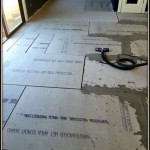Laying Self-Adhesive Vinyl Tiles Over Linoleum Flooring
Linoleum flooring, a classic choice for its durability and affordability, can sometimes feel outdated. Fortunately, a modern upgrade is readily available: self-adhesive vinyl tiles. These versatile tiles offer a quick and easy way to refresh the look of your linoleum floors without the hassle of a complete floor replacement. This article outlines the process of laying self-adhesive vinyl tiles over linoleum flooring, providing a step-by-step guide for a successful project.
Preparing the Linoleum Floor
The foundation for a successful vinyl tile installation lies in proper preparation. A smooth, clean linoleum surface ensures a seamless bond between the tiles and the existing floor. To achieve this, follow these steps:
1.
Clean the Floor Thoroughly:
Use a mild detergent and warm water to thoroughly clean the linoleum floor. Remove any dirt, grime, or residue that might interfere with the adhesive. Allow the floor to dry completely before proceeding.2.
Repair any Damage:
Inspect the linoleum floor for any cracks, holes, or loose tiles. Repair these imperfections using patching compound or epoxy filler, ensuring a smooth, level surface for the vinyl tiles.3.
Sand Uneven Areas:
If the linoleum floor has uneven areas, use a fine-grit sandpaper to smooth out the imperfections. This step ensures an even surface for the vinyl tiles and avoids any potential gaps or unevenness.4.
Prime the Floor:
Applying a bonding primer to the linoleum floor creates a stronger bond for the vinyl tiles. Choose a primer specifically designed for vinyl flooring and apply it evenly using a roller or brush. Allow the primer to dry completely before moving to the next step.Installing the Self-Adhesive Vinyl Tiles
Once the linoleum floor is prepped, you can proceed with installing the self-adhesive vinyl tiles. The process is relatively straightforward and involves the following steps:
1.
Plan the Tile Layout:
Measure the area where the tiles will be installed and determine the best layout for achieving a visually appealing design. Consider starting from the center of the room or from a corner, ensuring that the tiles are aligned properly and cut accurately.2.
Start from a Corner or Center:
Begin installing the tiles by starting from a corner or the center of the room. Ensure that the first few tiles are placed perfectly straight and level, serving as a reference point for subsequent tiles.3.
Apply Pressure:
Once a tile is positioned, apply firm, even pressure across the entire surface. This helps establish a strong bond with the adhesive backing of the tile. Use a roller or a heavy object to distribute the pressure evenly.4.
Cut Tiles for Edges:
Measure and cut tiles to fit around corners, doorways, and other obstacles. Use a utility knife or tile cutter to ensure clean, precise cuts. Remember to wear safety glasses and gloves during this process.5.
Maintain Consistent Spacing:
Ensure consistent spacing between tiles to create a uniform look. Use spacers or tile spacers to achieve the desired gap between tiles, which allows for natural expansion and contraction of the material.Essential Considerations for Successful Installation
While the process of laying self-adhesive vinyl tiles over linoleum flooring is generally straightforward, it's crucial to consider the following points to ensure a successful installation:
1.
Choose the Right Adhesive:
The adhesive backing of the vinyl tiles is crucial for their adherence to the existing linoleum floor. Ensure that the adhesive is strong enough to firmly bond to the linoleum surface. Consider using a pressure-sensitive adhesive for a strong and long-lasting bond.2.
Work in a Well-Ventilated Area:
Self-adhesive vinyl tiles may release fumes during installation. Ensure proper ventilation by opening windows or using fans to avoid inhaling any potentially harmful chemicals.3.
Allow for Curing Time:
After installation, allow the adhesive to fully cure for the duration specified by the manufacturer. This ensures a secure bond between the tiles and the existing floor, preventing peeling or lifting. Adhere to the manufacturer's recommendations for curing time to avoid damaging the installation.4.
Protect the New Flooring:
Once the adhesive has cured, protect the new vinyl flooring from damage by avoiding heavy objects or furniture until the adhesive has fully set. This precaution helps ensure the longevity and durability of the newly installed floor.
How To Tile Over Linoleum Floors Correctly

7 Things To Know Before Trying L And Stick Flooring

How To Install L And Stick Tile Over Linoleum My Homier Home

How To Install L And Stick Tile Over Linoleum

Adhesive Vinyl Flooring 4 Ways To Install Planeo

How To Lay Sheet Vinyl Flooring

How To Lay Vinyl Tiles Carpet Part 2 Laying The

Can You Lay Tile Over Linoleum Rubi Blog Usa

How To Install Luxury Vinyl Tile Over Linoleum

Should You Tile Over Vinyl Flooring Builddirect
Related Posts








